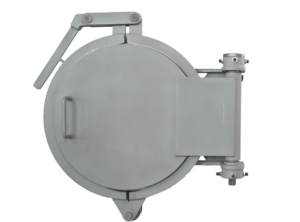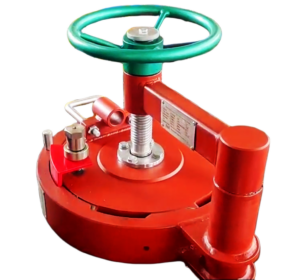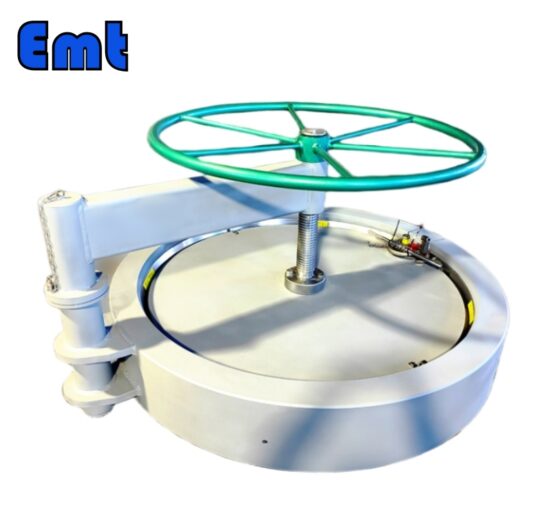What Is The Pressure Vessel Quick Opening Closure?
A hub, a cover, and a locking mechanism with a suitable sealing gasket make up EMT Pressure Vessel Quick Opening Closures. The opening or closing time of the Quick Opening Closure is much shorter if compared to a standard blind flange. For instance, according to ANSI B16.5 or ANSI B16.47, with bolts and nuts, the maintenance time of our QOCs is quicker and easier.
Besides, they are easy to use and install, and they can be applied to all kinds of pressure vessels. Therefore, there is no need for a special tool or experience to install them. The QOCs are made of corrosion resistant materials with a long life duration. So you do not need to worry about the corrosion problems.
Types of Pressure Vessel Quick Opening Closures

Lock Ring Quick Opening Closure
What is Lock Ring QOC?
Lock Ring QOC is designed, engineered, and manufactured as per strict international requirements that apply to pressure vessels in the oil, gas, wastewater treatment, petrochemical, and marine industries. We are providing our best services for the entire device, determining its lifetime accurately as well as its longest durability, through our in-house engineering services. Designed to ASME B31.4, ASME B31.8. Quick opening closures have an internal locking mechanism. All Quick Closures come in the sand-blasted and primer-coated color of your choice. Upon request, we can perform hydrostatic testing on Quick Closures. We supply maintenance spare parts for all our products. Each item comes with internal inspection and test documentation. Moreover, third-party inspection services are available if needed.
It’s vital to use the Lock Ring QOC right. Incorrect ones, like using a hammer to open the blind, could damage the safety chain system. First, the operator loosens the upper vent bolt by hand. If they hear a hiss or see oil, there’s still pressure. In that case, they must safely release the pressure. However, they can’t use the internal pressure relief port with the vent screw. Once there’s no pressure, the operator can unscrew the hollow screw by hand. A small chain links the hinge to the safety plug. As the screw loosens, the bolt ends lengthen until they touch the nut bracket. Then, the operator slides open the flange using the handle.
Key features
Nominal Diameter DN: <1800mm
Design pressure PN: ≤40 MPa
Working Medium: oil, gas, water
Design Temperature: -50℃~300℃
Material: 16Mn, A350LF2, A105, SS304, SS316, F51, F53, F55, INCONEL625, HASTELLOY C (Other materials can be chosen according to customer needs.)
Pipe Thickness: 6 to 100 mm (Other thicknesses can be customized; please get in touch with us)
The Lock Ring QOC features an inside groove locking band structure. It is meticulously designed, manufactured, and inspected following ASME code standards. Boasting high machining accuracy, the device offers quick and flexible opening and closing mechanisms. Moreover, safety interlocks ensure secure operations, while their compact structure enhances their appeal.
Specifically, it serves a critical role in the petroleum, chemical, and natural gas industries. Furthermore, in equipment such as pig launchers, pig receivers, filter separators, and various other pressure vessels, the Lock Ring QOC is the optimal choice.
Structures
Pressure alarm bolts and lock ring segment components
Locking mechanism (eccentric stop, stop nut, lock disc, horseshoe connection, lock ring lug, drive connection, lock ring, support nut, release bolt)
Pressure alarm bolt and lock ring segment (pressure alarm bolt, lock disc, and lock ring segment, sealing surface, gasket, door seal, pressure relief groove)
Parameters
Lock Ring Closure Characteristics | ||||
Design Pressure | 1.6MPa-30MPa | |||
Corrosion Allowance | 2mm | |||
Seismic Fortification Intensity | 7 Degrees | |||
Work Medium | Oil, Natural gas, water, ore pulp, etc. | |||
Opening Time | Within 60s less than 200N | |||
Opening Type | Vertical or Horizontal | |||
Band Quick Opening Closure

Band QOC is a kind of closure that is used for the circular opening of a pressure vessel or pressure pipeline. Turning to one side can achieve quick opening and closing.
Key features
Nominal Diameter DN: <1800mm
Design pressure PN: ≤40 MPa
Working Medium: oil, gas, water
Design Temperature: -50℃~300℃
Material: 16Mn, A350LF2, A105, SS304, SS316, F51, F53, F55, INCONEL625, HASTELLOY C (Other materials can be chosen according to customer needs.)
Pipe Thickness: 6 to 100 mm (Other thicknesses can be customized; please get in touch with us)
Parameters
Band Quick Opening Closure | ||||
Design Pressure | 1.6MPa-30MPa | |||
Corrosion Allowance | 2mm | |||
Seismic Fortification Intensity | 7 Degrees | |||
Work Medium | Oil, natural gas, water, ore pulp, etc. | |||
Opening Time | Within 60s less than 200N | |||
Opening Type | Vertical or Horizontal | |||
Plug Buckle Quick Opening Closure

What Is Plug Buckle QOC?
The Plug Buckle QOC is used on the circular opening of the pressure pipe or pressure vessel. It is a mechanical device that can be opened or closed quickly. It is generally composed of a simplified flange, head cover, hook ring or clamp, sealing ring, safety interlock mechanism, opening and closing mechanism, swivel arm and short section (when needed), and other components. The door support plate includes a lock ring support clamp dowel and bearing position, adjusting screws, a lock ring and locking mechanism, and universal handle.
Parameters
Standard Technical Specifications
| Lock Ring Type | Band Type | Plug Buckle Type | |
|---|---|---|---|
| Installation | Vertical/Horizontal | Vertical/Horizontal | Vertical |
| Size | DN 200 to DN 1200 | DN 150 to DN 1000 | DN 150 to DN 1000 |
| Pressure | ASME #150 to #1500 | ASME #150 & #300 | ASME #150 to #600 |
| Materials | SA 350 LF2 | SA 350 LF2 | SA 516 70N/SA 105N |
| Sealing | Viton™ | Viton™ | Viton™ |
Maintenance of Pressure Vessel Quick Opening Closure
Daily maintenance
During routine blind plate inspections and operations, it’s essential to avoid hitting or impacting the pressure components. Regularly, one should inspect the connection parts for any issues. Key pressure parts of the quick-opening blind plate, like the cover, flange, and lock ring, require consistent checks. If you encounter serious rust or cracks, promptly investigate the cause. Then, immediately consult with professionals to address the problem.
Maintenance of switching operations
Open the blind plate
First of all, before opening, confirm whether the natural gas in the container is all empty, and use the flat screwdriver to pry whether the safety chain device is retracted. Slowly loosen the pressure relief plug. If you hear a whistle, a bare sound, or a smell, it can be proven that residual pressure is inside the container. Then tighten the inclined release bolt and continue to empty until there is no residual pressure. Then remove all the pressure relief bolts and make them free from the bolt hole Open the lever and open the quick-opening blind plate.
It should be noted that the operator should not operate directly against the blind plate during the entire process.
Close the blind plate
First, check whether the lock belt and sealing belt are intact; there should be no obvious scratches or wear.
Then remove the dirt in the blind plate and the groove of the ball barrel, the locking belt, and the sealing place, and apply a thin layer of anti-corrosion silicon grease to the blind plate, the groove of the ball barrel, and the sealing surface.
Then insert one end of the universal handle into the lock ring drive arm, and turn the handle counterclockwise to make the lock band retractable to the lock band groove; Second, gently push the door forward, push to the position close to the flange, slightly push the roll, if the door is not in place, the lock ring cannot expand in place. Pushing the lever to close the door, so that the door is completely into the neck of the quick-opening blind plate, loosens the locking belt so that it is just stuck in the lock belt groove.
Next, pull the door back and forth several times to confirm that the expansion ring is fully stuck in the groove.
Finally, install the lock block, tighten the pressure relief plug, and close the blind plate.
Matters to Attention
First, when installing pressure relief bolts, be sure not to use brute force, and be careful not to tilt into the screw. Screw in with brute force, and tilting easily breaks the thread. After screwing in by hand, insert the long handle into the hole of the pressure relief bolt rod and tighten it firmly
Second, clean up the lock ring slot and apply grease. Apply grease to the parts of the lock ring that contact the door. The purpose is that the next time the blind plate is opened, it will be easier and will not rust
Third, the lock ring and the lock ring contact parts cannot be painted; otherwise, it will cause the lock ring to not operate or glide.
Accessory Instrumentation
QOC is always provided complete, either with a davit (for vertical installation) or a hinge (for horizontal installation), and with a safety warning device as per code.
Following are the additional accessories that can be supplied on customer request:
key interlock system
limit switches for open/close position feedback
single point for opening or closing operation
the protective cover to protect the QOC from dust and dirt.
QOC comes complete with a davit for vertical setups or a hinge for horizontal ones. It includes a safety warning device as required by the code. Additionally, customers can request extra accessories: A key interlock system enhances security. Limit switches offer open/close position alerts. They help monitor the closure’s status effectively. A single point allows for easier operation. It simplifies the opening or closing process. A protective cover shields the QOC from dust and dirt. It keeps the closure clean and operational.
Typical Applications of The Pressure Vessel Quick Opening Closures
Installation on the access opening of a pressure vessel
Pressure vessel quick opening closures are designed to fit snugly on access points, enabling easy entry. Consequently, they facilitate swift maintenance and inspection.
Furthermore, they create a secure seal on vessels, even under high pressure. This feature guarantees safe operation across a spectrum of industrial conditions.
Installation of scraper traps
Install them on scraper trap systems. These systems clean and inspect pipelines efficiently. They ensure a tight seal when scrapers pass through. This prevents leaks and maintains pipeline integrity. Quick opening closures facilitate easy scraper retrieval. They allow for quick removal after pipeline cleaning operations.
Conclusion
At EMT, we specialize in crafting Lock Ring QOCs suitable for pipelines from 2” to 48” (DN50 to DN1200). Recognizing varied industry demands, we ensure our closures meet ASME B31.3/B31.4/B31.8/CSA Z662 Cat. II standards and are designed with a robust 0.5/0.6 safety factor. Our Lock Ring Style Closure, known for its high-quality components, user-friendly design, and safety emphasis, serves as an exceptional solution for pipeline systems.
Moreover, we boast extensive experience in delivering Pressure Vessel Quick Opening Closures and bespoke equipment. As one of China’s leading manufacturers and suppliers of pipe products, we invite and warmly welcome you to purchase from our range. “Quality first” is our guiding principle. We earnestly look forward to collaborating with you and fostering a mutually beneficial relationship.







There are no reviews yet.